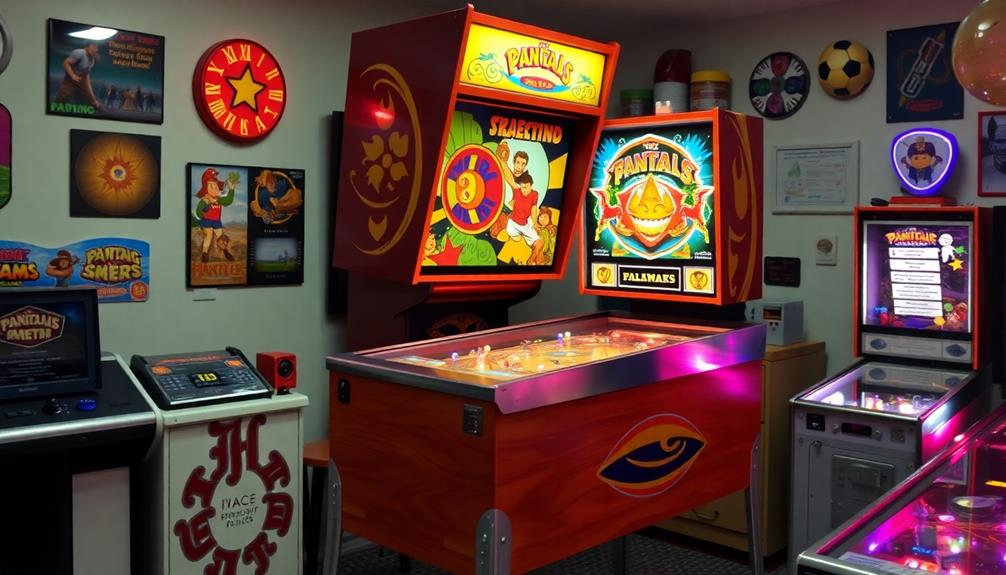A pinball machine is made up of various key components that come together to shape the overall gameplay experience. The playfield is where you’ll find ramps, bumpers, and targets that allow you to earn points. The flippers, which are controlled by buttons on the sides, help guide the ball towards these scoring opportunities. A plunger is used to launch the ball at the beginning of the game. Additionally, there is a backbox that displays your scores. Tilt sensors help maintain the integrity of the game by detecting excessive nudging, while bumpers create excitement with their unpredictable movements. Each element plays a unique role in the game, and by sticking around, you’ll discover more about how these parts enhance your pinball journey.
Key Takeaways
- The playfield is the central area featuring ramps, bumpers, targets, and holes for engaging gameplay and scoring opportunities.
- Flippers control the ball's direction and are essential for hitting targets to maximize scoring potential.
- The backbox displays scores and game information, enhancing the visual appeal and player engagement.
- Bumpers act as immediate scoring mechanisms that launch the ball upon contact, adding excitement to gameplay.
- Tilt sensors ensure fair play by detecting excessive nudging, preventing cheating and maintaining game integrity.
Overview of Pinball Components
A pinball machine is a complex yet fascinating assembly of components that work together to create an engaging gaming experience. At its core lies the playfield, where the action unfolds. This area is designed with various features like bumpers and holes that challenge your skills and offer scoring opportunities, much like how astrology claims to influence personality traits.
You'll notice the vibrant artwork and intricate layout, all aimed at keeping you engaged.
Your primary interaction with the game happens through the flipper buttons located on the sides of the cabinet. When you press these buttons, they activate the flippers, allowing you to control the ball's movement and aim for targets. Mastering the timing and precision of your flipper taps is essential for executing effective gameplay strategies.
Additionally, the cabinet houses the backbox, which displays scores and game information. This area also features backglass artwork that enhances the machine's visual appeal.
Other components, such as drop targets and tilt sensors, play significant roles in maintaining fair gameplay and adding to the excitement. Together, these elements create a dynamic environment that keeps you coming back for more.
Understanding the Playfield
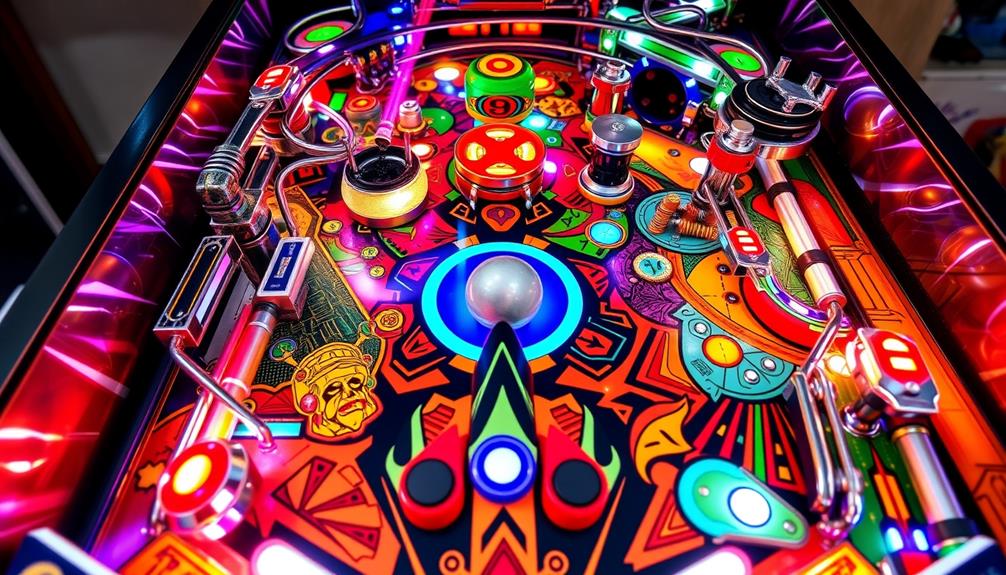
The playfield is the heart of your pinball experience, featuring a mix of ramps, bumpers, and targets that create both challenges and scoring opportunities.
Understanding the design elements can reveal strategies akin to the principles of fostering creative problem-solving in design thinking.
By understanding its design and scoring mechanisms, you can develop strategies to enhance your gameplay.
Let's explore how these elements work together to maximize your points.
Playfield Design Features
In pinball, the playfield serves as the heart of the machine, where the action unfolds and excitement builds. It's typically inclined at 6-7 degrees, allowing gravity to enhance the ball's movement and gameplay dynamics.
Understanding the design features of the playfield is essential for mastering the game, much like how the best ways to patch an air mattress can enhance your experience with inflatable products.
Here are some key components you'll encounter on the playfield:
- Bumpers: These round knobs propel the ball away upon contact, adding thrill and contributing to your score.
- Holes: Some holes offer significant bonuses and points, while others can either return the ball to play or keep it from doing so.
- Targets: These can vary in type and placement, providing various scoring opportunities as you aim for them.
- Ramps: Ramps guide the ball to different areas of the playfield, creating unique challenges and scoring paths.
To maximize your scoring potential, you need to familiarize yourself with the layout beneath the playfield glass.
Developing effective ball manipulation strategies will enhance your gameplay experience and help you conquer the challenges ahead!
Scoring Mechanisms Overview
Understanding scoring mechanisms is essential for any pinball enthusiast enthusiastic to maximize their gameplay. In pinball, you'll encounter various elements that contribute to your score. Active and passive bumpers play a vital role by either launching the ball or registering points when struck. Mastering the use of the flipper button is key to directing the ball towards valuable targets.
Here's a breakdown of key scoring mechanisms:
| Scoring Mechanism | Description |
|---|---|
| Bumpers | Propel the ball or register hits |
| Drop Targets | Lower when hit, scoring increases with multiples |
| Bash Toys | Award extra points when struck |
| Skill Shots | Special launch techniques yield bonuses |
Function of the Plunger
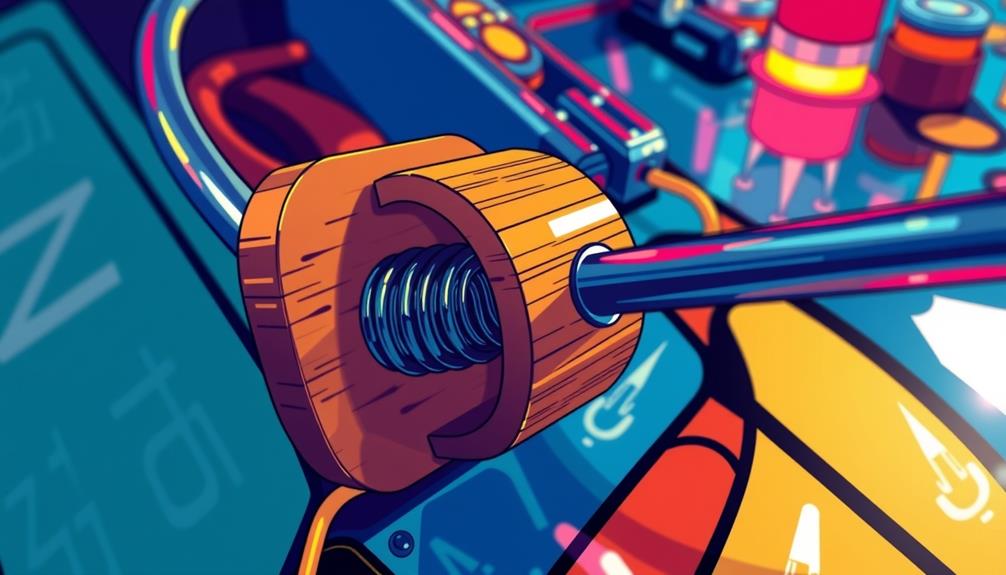
At the front of the pinball cabinet lies the plunger, an essential component that enables you to launch the ball into the playfield. This spring-loaded rod is your primary tool for kicking off the game or introducing a new ball.
Understanding how to use the plunger effectively can greatly enhance your gameplay experience. Just like how the essence of a perfect day can be captured in a song like Blue Skies and Lemonade, mastering the plunger can create a joyful and nostalgic gameplay atmosphere.
With the plunger, you can control the ball's launch force, allowing for strategic placement as you aim for targets on the playfield. Here are some key points to take into account:
- Launch Control: Adjust the force to influence the ball's speed and direction.
- Initial Strategy: Your first shot can set the tone for your entire game.
- Ball Management: Proper plunger use helps you manage the ball effectively.
- Scoring Opportunities: A well-placed launch can result in maximizing your score.
Mastering the plunger isn't just about launching the ball; it's about leveraging that launch to enhance your overall strategy.
Once you grasp its mechanics, you'll find that the plunger plays a vital role in your journey to high scores and exciting gameplay moments.
Role of Flippers

Mastering the flippers can elevate your pinball game to new heights. Flippers are the controlled levers on the sides of the cabinet that direct the ball towards targets, making them essential for scoring points.
Since their introduction in the Humpty Dumpty machine, flippers have transformed gameplay by allowing you to actively control the ball's trajectory. This evolution in design reflects a broader trend in creative expression and imagination within the gaming industry, showcasing how innovation can reshape traditional experiences artistic insights encourage innovation.
You can operate flippers mechanically or electronically, but their precision is critical for executing various strategies, like skill shots and multi-ball modes. By honing your flipper techniques, such as cradling the ball and using dead flips, you'll enhance your ability to manage ball control, which can lead to higher scores and longer gameplay.
As you practice, you'll find that successful flipper use markedly impacts your overall performance. Flippers aren't just a feature; they're a key component of player skill development in pinball.
Importance of Bumpers

Bumpers play an essential role in your scoring strategy, acting as immediate scoring mechanisms when the ball makes contact.
Their dynamic interaction with the ball not only creates unpredictable movements but also enhances your gameplay experience.
Understanding the importance of content quality in engaging players can further elevate your pinball skills.
Scoring Mechanisms Overview
In the dynamic world of pinball, bumpers play an integral role in scoring and gameplay. These round knobs on the playfield not only propel the ball away upon activation but also contribute considerably to your overall score.
Understanding how bumpers function can enhance your game strategy and improve your scoring potential. Just like how essential oils for toothache relief can alleviate discomfort, mastering bumpers can alleviate the challenges of the game.
Here are some key aspects to reflect on about bumpers:
- Active Bumpers: They score points by launching the ball into play, adding excitement to your shots.
- Passive Bumpers: These register hits without affecting ball movement, giving you a chance to rack up points even when the ball is stationary.
- Scoring Potential: Hitting bumpers can release multipliers and bonus points, vital for maximizing your score.
- Placement Strategy: Knowing where bumpers are located helps you develop effective ball control strategies, ensuring you hit them consistently.
Incorporating bumpers into your gameplay not only enhances the challenge but also boosts your scoring opportunities. Aim for those bumpers, and you'll find yourself climbing the scoreboards faster than ever!
Ball Interaction Dynamics
When you're steering through the fast-paced environment of a pinball machine, understanding ball interaction dynamics is essential for elevating your gameplay. One of the key elements in this dynamic is the bumpers. These round knobs on the playfield activate upon contact with the ball, launching it away and creating exciting scoring opportunities. Each active bumper registers hits, contributing to your score while challenging your ability to maintain control.
Additionally, incorporating principles from music therapy integration can enhance your focus and reaction time, making for an even more engaging experience.
Modern bumpers often have enhanced mechanisms that offer varied scoring bonuses based on the speed and angle of the ball's contact. This means that the way you approach each bumper can greatly influence your results. By learning the placement and functionality of bumpers, you can develop effective strategies for ball manipulation, maximizing your points during gameplay.
The interaction between the ball and bumpers highlights the importance of your skill as a player. Successfully maneuvering through these elements not only keeps the ball in play but also raises your chances of achieving high scores.
Player Strategy Enhancement
Players often find that mastering bumpers can greatly enhance their overall strategy in pinball.
These round knobs on the playfield serve as crucial elements that not only interact with the ball but also propel it away, creating numerous scoring opportunities. By understanding the placement and function of bumpers, you can considerably improve your gameplay.
Additionally, employing a solid budgeting plan for your gaming expenses can help you invest wisely in your pinball pursuits.
Here are some strategies to maximize your scoring potential with bumpers:
- Target active bumpers: Hitting bumpers when they're lit can lead to bonus points.
- Create unpredictable ball movements: Use bumpers to keep your opponents guessing and adapt your gameplay.
- Trigger multi-ball modes: Successfully hitting multiple bumpers in succession can activate special game features.
- Develop ball control techniques: Mastering bumpers allows you to control the ball's path effectively, enhancing your overall scoring strategy.
Significance of Tilt Sensors
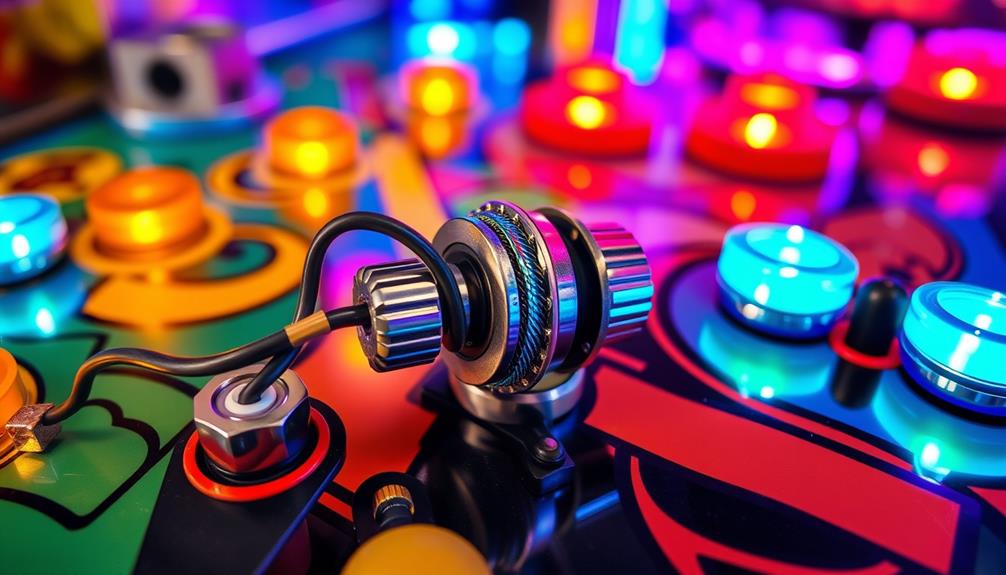
Tilt sensors play an essential role in the operation of pinball machines by detecting excessive nudging or movement that could indicate cheating. When you're playing pinball, it's vital to understand how these sensors work to avoid penalties. Modern tilt sensors allow for limited nudging before a tilt is triggered, unlike older designs that would lock flippers and disable solenoids entirely.
The tilt mechanism includes a tilt bob and a slam tilt switch, which prevent aggressive behaviors. Here's a quick overview of the tilt sensor functions:
| Function | Old Design | Modern Design |
|---|---|---|
| Tilt Activation | Locks flippers and solenoids | Allows limited nudging |
| Slam Tilt Detection | Triggers from slight nudging | Triggers from forceful nudging |
| Game Integrity | Maintains strict penalties | Offers a more forgiving approach |
| Player Strategy | Encourages cautious play | Allows strategic nudging |
| Fair Play | High penalty for all violations | Balances play with minimal penalties |
Understanding tilt sensors will help you hone your skills while ensuring a fair playing experience for everyone.
Scoring Mechanisms Explained
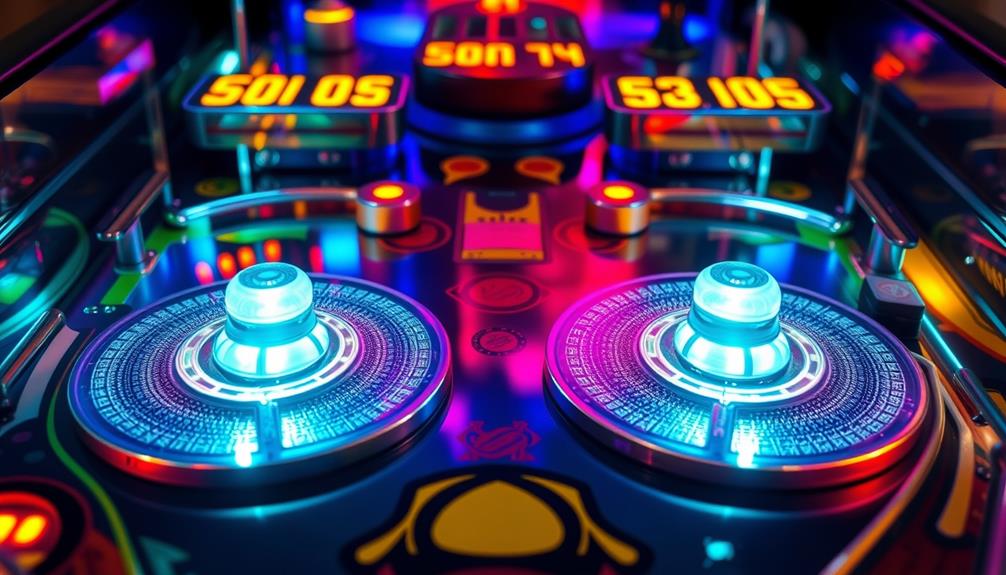
Scoring mechanisms in pinball machines are designed to keep the gameplay exciting and rewarding. As you play, you'll notice various elements that contribute to your score, similar to how different brewing methods affect caffeine content greatly in coffee. Understanding these mechanisms is key to maximizing your points and enhancing your overall experience.
Here are some essential scoring components:
- Active bumpers: These propel the ball away upon contact, adding to your score as you hit them.
- Passive bumpers: Unlike active ones, they register hits without moving the ball but still provide points based on frequency.
- Bash toys: These interactive elements reward extra points when struck by the ball, encouraging you to aim for them.
- Drop targets: When hit, these targets lower and can yield considerable points, especially when hit in groups.
Your skill with the flippers also plays an important role in taking full advantage of these scoring mechanisms. Precise control can lead to more successful hits on active bumpers and other scoring elements, ultimately boosting your score.
Gameplay Dynamics
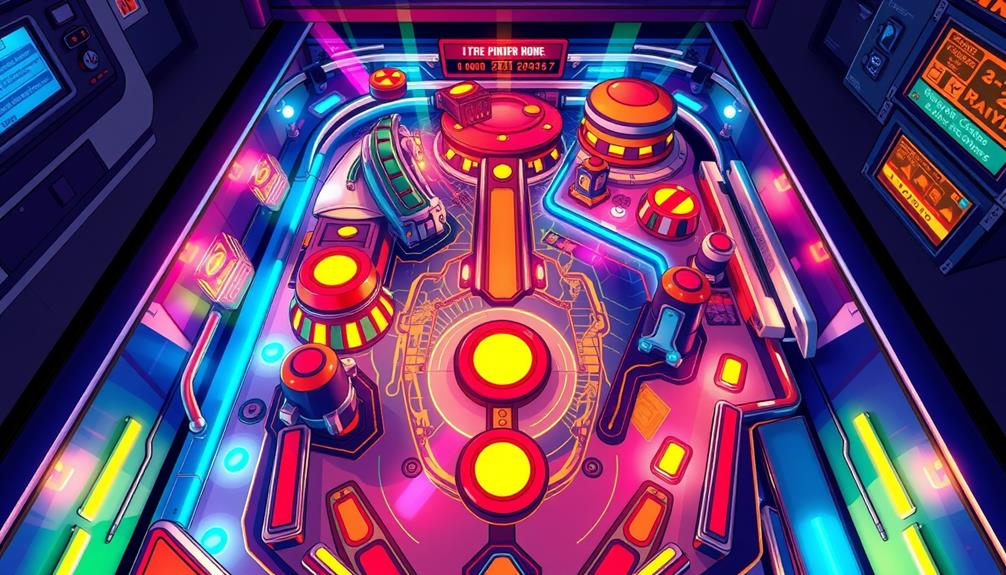
In pinball, mastering ball management techniques can greatly boost your score.
With the increasing complexity of modern machines, understanding gameplay dynamics is akin to the evolving roles in tech, such as AI Cybersecurity Jobs, where adaptability is key.
You'll find that the balance of skill versus chance plays an essential role in your success, especially when it comes to controlling the flipper buttons.
Each shot you make not only affects your immediate score but also shapes your overall gameplay experience.
Ball Management Techniques
Mastering ball management techniques is essential for any pinball player looking to elevate their game. Understanding how to keep the ball in play not only maximizes your scoring opportunities but also minimizes the risk of losing it to outlanes.
Here are some key strategies to improve your gameplay:
- Flipper Control: Use your flippers strategically, timing your flips to direct the ball towards high-scoring targets or to prevent it from draining.
- Cradling the Ball: Hold the ball on a flipper to assess the playfield, allowing for ideal shot selection and better scoring chances.
- Effective Nudging: Manipulate the ball's trajectory with nudging techniques to avoid drains or hit desirable targets, but be cautious of tilt sensors.
- Skill Shots: Aim for skill shots during ball launches to greatly boost your scores and gain game advantages.
Skill Versus Chance
Pinball combines skill with chance, creating a dynamic gameplay experience that challenges players to adapt to both their own abilities and the randomness of the playfield. Your precision in flipper control directly influences the ball's trajectory and scoring opportunities.
You can enhance your skills by mastering techniques like cradling the ball or executing dead flips, which help you control the game's flow.
Nonetheless, the playfield's layout, with its bumpers and holes, introduces an element of chance. You'll often find yourself responding to unpredictable ball movements, making quick decisions that can either set you up for a high score or send the ball away unexpectedly.
Skill shots, particularly super skill shots, reward your ability to launch the ball accurately into specific targets, showcasing the importance of player control.
Adding to the complexity, tilt sensors require you to balance aggressive nudging to influence the ball's path while avoiding a tilt that ends your game.
This interplay of skill and chance keeps you engaged and constantly adjusting your strategy, making each game unique and exciting.
Flipper Button Control
Flipper button control is essential for shaping your pinball experience and maximizing your score. The flipper buttons, located on the sides of the pinball cabinet, allow you to control the flippers effectively. Each press activates an electromagnetic coil, providing quick and responsive movement to strike the ball.
To excel in pinball, you'll want to master the following techniques:
- Timing: Press the flipper buttons at the right moment to hit targets.
- Precision: Aim for specific areas on the playfield to direct the ball strategically.
- Advanced Techniques: Learn skills like dead flipping and passing the ball between flippers.
- Sensitivity Awareness: Different machines may have varying flipper button sensitivity, so adapt your approach accordingly.
Mastering flipper button control considerably enhances your scoring potential and overall gameplay strategy.
With practice, you'll refine your timing and precision, allowing for more advanced maneuvers. Remember, the more you control the flippers effectively, the better your chances of achieving high scores and enjoying the game to its fullest.
Maintenance and Troubleshooting
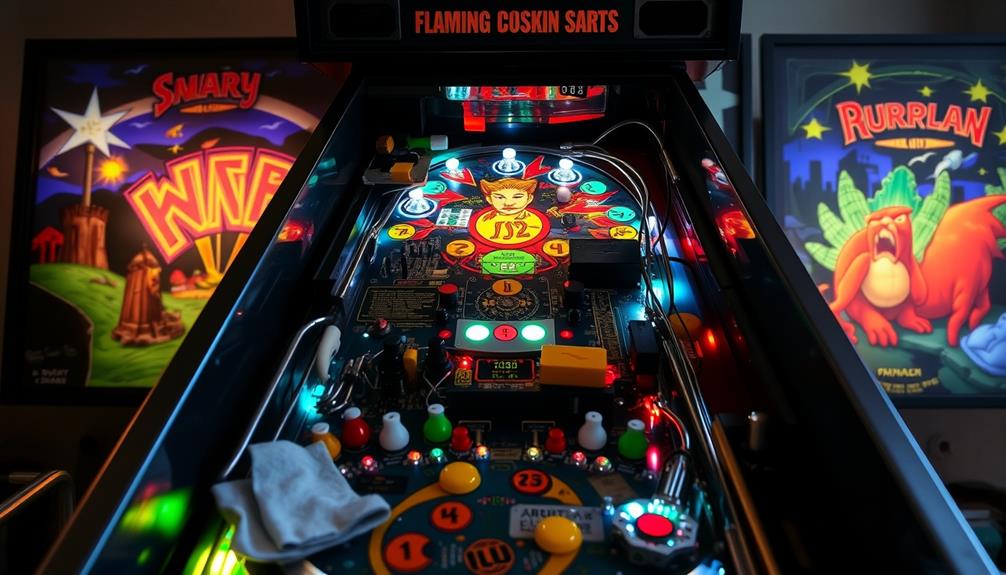
Maintaining a pinball machine is vital for guaranteeing both ideal gameplay and the longevity of the device. Regular cleaning of the playfield and its parts is essential; dust and debris can affect ball movement and scoring. If you notice non-responsive switches, check the connections and replace any faulty components. Misalignment of the tilt mechanism can lead to false tilting, so make certain the tilt bob is properly positioned.
To help you with maintenance and troubleshooting, here's a quick reference table:
| Issue | Solution | Tools Needed |
|---|---|---|
| Dirty playfield | Clean with a soft cloth | Cleaning solution |
| Non-responsive switches | Check connections, replace parts | Multimeter, screwdriver |
| Tilt mechanism misaligned | Adjust tilt bob position | Screwdriver |
| Display malfunctions | Inspect and secure connections | Multimeter, pliers |
Also, verify the coin door functions properly for internal access. This will help you troubleshoot issues and collect takings from the machine effectively. By regularly performing these maintenance tasks, you'll keep your pinball machine running smoothly for years to come.
Historical Evolution of Pinball
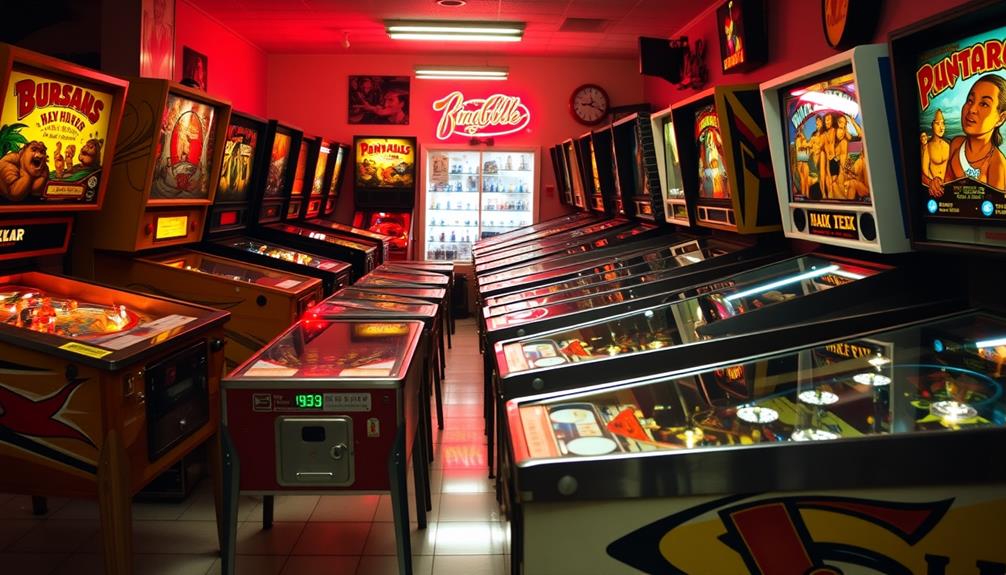
The journey of pinball machines reflects a fascinating evolution in gaming technology and design. Starting from the Electro Mechanical (EM) era (1947-1978), you'll notice how mechanical scoring devices converted pinball from purely mechanical to incorporating electrical components.
Next came the Alphanumeric era (1979-1989), which integrated microchips and digital controls for more complex gameplay.
As you explore the Dot Matrix Display (DMD) era (circa 1990-2012), you'll see animated displays enhancing player engagement and introducing wizard modes.
Now, in the Liquid Crystal Display (LCD) era (2013-present), modern pinball machines feature multi-colored animations and detailed scoring information, maintaining gameplay while fostering deeper interaction.
Key milestones in the historical evolution of pinball include:
- The introduction of mechanical scoring in EM machines.
- The rise of microchips in the Alphanumeric era.
- Animated displays in the DMD era.
- Multi-colored animations in the LCD era.
Looking ahead, future innovations may include WIFI connectivity and customizable playfields, further altering how you experience the parts of a pinball machine.
Each era showcases the remarkable growth and creativity in pinball design that continues to captivate players today.
Frequently Asked Questions
What Are the Things in a Pinball Machine Called?
In a pinball machine, you'll find various components like the playfield, flippers, bumpers, and the backbox. Each part plays an essential role in enhancing your gaming experience and maximizing your scoring potential. One of the most important components of a pinball machine is the playfield, which is the area where the ball rolls around and interacts with various targets and obstacles. Keeping the playfield clean and free of debris is crucial for maintaining the smooth movement of the ball and preventing damage to the machine. There are various cleaning solutions specifically designed for pinball playfields that can help keep your machine in top condition. It’s important to regularly clean and maintain your playfield using the best cleaning solutions for pinball playfield to ensure optimal performance and longevity of your machine.
What Are the Necessary Components of a Pinball Machine?
To enjoy a pinball machine, you need key components: a playfield for action, flippers for control, a plunger to launch the ball, a backbox for displays, and tilt sensors for fair play.
What Are the Arms on a Pinball Machine Called?
You'll find that the arms on a pinball machine are called flippers. These essential components let you control the ball's movement, enhancing your gameplay and allowing for various techniques to improve your scoring strategies.
How Many Parts Does a Pinball Machine Have?
A pinball machine's like a bustling city, filled with over 1,000 parts working together. You'll find everything from flippers to bumpers, each contributing to the excitement and challenge of your gaming experience. There is a wide range of themes to choose from in a variety of pinball machines, including everything from classic movies to popular TV shows. The constant flashing lights and sounds create a sensory overload that keeps players coming back for more. With so many different machines to choose from, you can find one that suits your interests and skill level.
Conclusion
In conclusion, understanding the parts of a pinball machine enhances your gameplay experience. From the thrilling plunger to the agile flippers and the lively bumpers, each component plays a vital role in keeping the game exciting. As you navigate the playfield, remember that a bit of maintenance can go a long way—like fixing a dial-up connection in a Wi-Fi world. So, immerse yourself, have fun, and let the nostalgia of pinball transport you back to simpler times!




